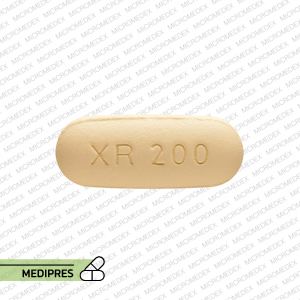
Selfemra
23 June, 2023
Simponi Aria
23 June, 2023Seroquel XR
Generic name:
Quetiapine fumarate extended-release
Drug class:
Atypical antipsychotic (second-generation antipsychotic)
Dosage form:
Extended-release tablets (50 mg, 150 mg, 200 mg, 300 mg, 400 mg)
Root of administration:
Oral
Dose:
Schizophrenia (adults): initiate 300 mg once daily, titrate to 400–800 mg; Bipolar mania/mixed episodes: start 300 mg once daily, titrate to 300–800 mg; Bipolar depression: up to 300 mg once daily; Adjunctive in major depressive disorder: 50–300 mg once daily; Geriatric patients: initiate at 50 mg, titrate slowly; Varies by indication; consult label for detailed dosing.
Mechanism of action:
Quetiapine XR antagonizes serotonin 5-HT2A, dopamine D2, histamine H1, and adrenergic α1/α2 receptors, with higher affinity for 5-HT2A than D2, modulating neurotransmitter activity to alleviate psychotic symptoms and stabilize mood.
Drug usage cases:
- Schizophrenia in adults
- Bipolar disorder: manic and mixed episodes
- Bipolar depression
- Major depressive disorder (adjunctive therapy)
- Generalized anxiety disorder (off-label)
- Post-traumatic stress disorder (off-label)
- Insomnia (off-label, low dose)
Drug contra indications:
- Hypersensitivity to quetiapine or its components
- Concomitant use with strong CYP3A4 inhibitors (e.g., ketoconazole)
- History of severe cardiac arrhythmias or QT prolongation
- Neuroleptic malignant syndrome
- Severe CNS depression or comatose state
- Breastfeeding (absolute contraindication)
Side effects:
- Somnolence
- Dizziness
- Dry mouth
- Constipation
- Orthostatic hypotension
- Weight gain
- Metabolic changes (hyperglycemia, dyslipidemia)
- Headache
- Fatigue
- Blurred vision
- Elevated liver enzymes
- Extrapyramidal symptoms (rare)
- Akathisia
- Tardive dyskinesia
- Seizures (dose-related risk)
- QT prolongation
- Thrombocytopenia and other blood dyscrasias (rare)
- Neuroleptic malignant syndrome
Warnings:
- Elderly patients with dementia-related psychosis increased risk of death
- Risk of suicidal thoughts and behaviors in young patients
- Orthostatic hypotension and syncope, especially during dose titration
- Metabolic syndrome: monitor weight, blood glucose, lipids
- QT interval prolongation: caution with other QT-prolonging agents
- Neuroleptic malignant syndrome: discontinue if suspected
- Drug interactions with CYP3A4 inhibitors/inducers
- Potential withdrawal symptoms: taper gradually
- Ophthalmic monitoring for cataracts recommended
- Sleep-related behaviors (e.g., somnambulism, driving) reported
Use during pregnancy or breastfeeding:
Pregnancy: Category C. Animal studies indicate fetal risk; prescribe only if benefits justify potential risks. Monitor neonates for extrapyramidal or withdrawal symptoms. Breastfeeding: Quetiapine is excreted in breast milk; potential sedation and adverse effects in the infant; advise against breastfeeding or discontinue therapy.



